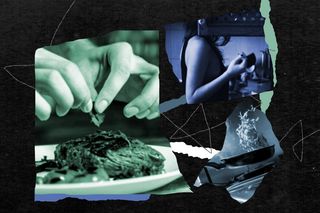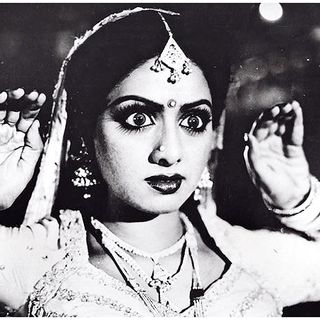
In Quarantine, Capturing Our Chores on Social Media Gives Us a Sense of Community
As the pandemic upturns how individuals communicate and seek affection, documenting everyday rituals keeps us sane.

A vast, absurd change in life makes one yearn for the familiar. In sickness and pain, we crave the comfort of food cooked at home. After migrating to the loneliness of alien lands, we yearn for the friendliness of known places. Quarantines are curious in that sense — they confine us to the familiarity of home and those close to us, while taking away much of our convenience. As the pandemic swept across nations, people began documenting their lives in isolation, and the breath of change was astounding. Once littered with clothing and vacations, the stories, posts, and captions we now see diarize daily chores — cooking one’s own meals, cleaning out closets, rearranging bookshelves, and sweeping houses. The scale of this ranges from a friend helpfully explaining how to make dal on Instagram stories, to Katrina Kaif sweeping the floor, and Malaika Arora Khan making stew.
Everything we do on social media is an attempt to be liked, and the documentation of our mundane lives is a testament to that. The Internet has taught us to spin our lives into content well enough for us to know that our indoor lifestyles will pique interest. But, there is no inherent harm in documentation — ritually capturing something like the process of cooking is one way to revel in the experience. When this becomes a ritual, it might even enhance how we enjoy our food. Ritualizing novelty, however, could also be an empty dopamine rush — and considering our prolific use of social mediums, we’re probably all there — each post is the small hit of joy that gives energy and motivation to do the daily things we all need to do.
Yet, the documentation of rituals like cooking and cleaning are a touch more important than our mere need for online affection. Rituals give us the impression of permanence, consistency, something that always has been, according to theatre director Richard Schechner’s text —Performance Studies: An Introduction. Amid a vast, absurd change like a civilization-threatening pandemic, the ritual’s importance is further magnified, via adding something to hold on to in a shifting landscape. And the documentation of rituals online occurs is to share them with a community — the very thing the pandemic has torn from us. Via rituals, we share our commonalities and stick together.
Related on The Swaddle:
Why Do We Still Worship Celebrities in 2018?
This powerful relationship between our need to feel liked and the need for loving communities is magnified when celebrities make relatable content. Even though the charm of celebrity is in its mystique and opulence, celebrities are washing dishes and swabbing floors during the quarantine. However, rather than repel people, this no-frills behavior makes fans love a celebrity more. Culture critic and philosopher Roland Barthes posited this theory in his book —Mythologies, where he writes of feeling a certain privilege when he reads little asides about his favorite writers. Barthes believed that so-called benign admissions of someone revered only seem to elevate their heroism. Similarly, watching a beloved celebrity sweep floors in their home during a lockdown lends fans a peek into their inner sanctum — which makes fans feel more affection for the celebrity.
For the celebrity in lockdown, this is beneficial, as public affection is necessary for their source of income. However, for a regular person, employment often doesn’t depend on large-scale public love. In this case, the formation of community is not as large-scale as that of the celebrity, but frequently more close-knit and emotionally satisfying for both the individual who posts and those who follow the posts. On smaller scales, the ritualistic sharing of our lives within quarantine builds chatter, engagement, and community — connections that double in importance when physical contact, or even proximity, is impossible.
Related on The Swaddle:
Why You Have the Social Media Blues
Susan Sontag’s well-loved essay On Photography confirms our need to document to be within reach of the community, by writing of the camera as a cherished tool within families. She writes, “Through photographs, each family constructs a portrait-chronicle of itself — a portable kit of images that bears witness to its connectedness. It hardly matters what activities are photographed so long as photographs get taken and are cherished.” Similarly, in smaller scales and individual accounts, our love for online documentation, especially that of shared experiences like doing chores, is intended for those who cherish us, and expands to fit in those who discover us and come to cherish us.
As the way we survive changes rapidly, so does the way we communicate. While our sources of entertainment are limited, communication also exists as a means to pass the time. Capturing and narrating our daily rituals both swallows up large chunks of the time we’d spend worrying and tethers us both to sanity, and each other. Often, the amount of bandwidth we give to social media, if large, is linked to narcissistic tendencies. A simple need to feel seen does not translate to narcissism, especially in times like ours. As the horror of a gradually escalating pandemic and the crushing loneliness of no physical contact arrests us, it is the sharing of rituals that keep us from madness. Perhaps, that’s a good enough excuse to document our mundanities a little more freely.
Aditi Murti is a culture writer at The Swaddle. Previously, she worked as a freelance journalist focused on gender and cities. Find her on social media @aditimurti.
Related


Woe Is Me! “I Think My Friend Can’t Keep Secrets Because She’s Too Loud!”
